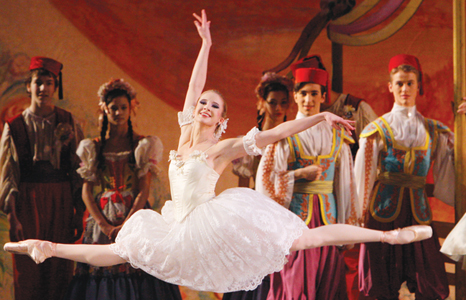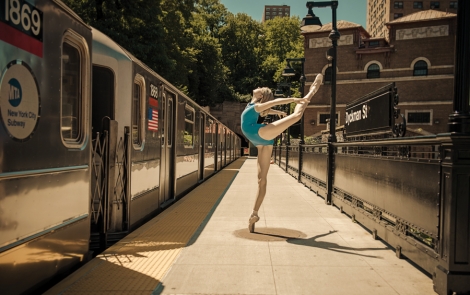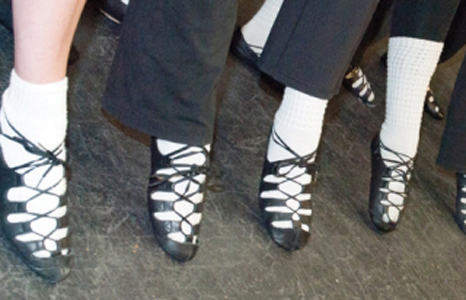Sterling Hyltin, a principal dancer with the New York City Ballet, is as good as her name – a graceful ballerina known for her kicky, flirty performances in smart, sexy roles but also a gracious young woman who offers to continue our conversation on another day to make sure we get all the answers to our questions on the use and care of hands and feet in the ballet.
What she has to say on the subject is revelatory to say the least. It will also make you glad if your worst encounter is with a pair of unyielding stilettos.
We begin with a discussion of hands, often overlooked by lovers of the dance who are so bewitched by fleet feet. But hands are important, no?
“Absolutely, as far as hands go, they may get there last, but they have to get there,” she says.
Meaning, she adds, that the hands not only connect with, hold and caress a partner or link with other dancers.
“Sometimes the hand isn’t what you’re supposed to look at, but it gestures to another part of the body.”
As in “Mozartiana,” a soulful tribute to Wolfgang Amadeus by way of Tchaikovsky and George Balanchine, who co-founded City Ballet with Lincoln Kirstein. It’s a work that Hyltin (pronounced hill-TEEN) describes as “a full meal with a hearty role for the ballerina.”
Ultimately in ballet, the hands finish the line of the body, serving as a bridge to the air. And there must be no impediment to that transparent bridge. At City Ballet, the hands are “naked,” she says. Female dancers can wear clear nail polish. The married ones may choose to wear their wedding rings. But there are no bold nail lacquers, gloves or flashy jewelry, unless a role requires them.
The feet are more complex and what everyone wants to know about, right? For toe or pointe shoes are like a nun’s veil, a symbol of a rite of passage into a world few of us will ever enter. Hyltin says she doesn’t remember the exact age she began pointe work – it usually starts between ages 11 and 14, not so coincidentally around the time of puberty – but says, “I loved it right away.”
The Amarillo, Texas, native began her dance training at age 6 with the Dallas Metropolitan Ballet, entering the School of American Ballet, City Ballet’s official school, in the fall of 2000. When she became an apprentice with the company two years later, she stepped into another dancer’s shoes, those of former corps de ballet member Megan Pepin, literally. They fit perfectly.
But Hyltin was on the way to shoes of her own. She joined the corps in 2003, became a soloist three years later and a principal in 2007. Along the way she has shown striking diversity – originating the role of Juliet in “Romeo + Juliet” by ballet master in chief Peter Martins; bringing a saucy edge to the main ballerina in the “Rubies” section of Balanchine’s “Jewels”; and playing the shrewd village girl who teaches her bumpkin of a boyfriend a thing or two about the power of womanhood in the comedy ballet “Coppélia.”
Like most of the women in her company, Hyltin gets her pointe shoes from Freed of London, which has been making them by hand in that city since 1929, although the company has a location in Long Island City. The shoes are peachy pink (they can be dyed for different roles); are made of satin with a wood toe box; and are tailored to the ballerina’s measurements and specifications.
“Some dancers like more satin on the sides. Others don’t want the shoes to be cut as high.”
Hyltin likes more satin, because she thinks it looks better on her feet. (At 5 foot, 4 inches – 5 foot, 8 inches on pointe – she wears a size 4 toe shoe, which translates into a size 6½ street shoe.) Even without the extra satin, you would know a Hyltin pointe shoe: Her name is on the bottom.
There are all kinds of urban legends about ballerinas taking the peach beauties reverently in their hands and then taking a hammer to them to soften them up. Not exactly but close enough. The first thing Hyltin does when she takes a pair out of the box is to turn them over and step on them. Then she bends them at the “shank,” which supports the ball of the foot. (Dancers also bang the shoes against a wall before going onstage.)
Hyltin sews the elastics on the heel and then the ribbons. If there’s one thing she’s obsessive about, it’s her heels, so she’ll tug the shoes up once or twice before going out onstage, even though she doesn’t need to.
With class, rehearsal and performance all in the mix, Hyltin can dance anywhere from four to eight hours a day and go through nine pairs of toe shoes in a week. On one day alone, she went through two pairs in five hours of rehearsal, though she says she tries to salvage the seasoned ones for rehearsals that don’t require as hard a shoe. Once the shoes have “died” – yes, that’s the technical term for it – the ribbons are snipped off to be used on other shoes. Periodically, autographed pairs of dead shoes make their way to the City Ballet Gift Shop on the promenade of the David H. Koch Theater at Lincoln Center. There are few things more poignant than these battered beauties, like shells strewn along the sand, awaiting new homes and others to love them.
Love doesn’t come cheap. Toe shoes can cost anywhere from $30 to $75 per pair, and companies like Pittsburgh Ballet Theatre spend close to $100,000 a year footing the bill.
So toe shoes can be hard on the budget though probably harder on the bunions.
“I’ve danced with a sprained ankle and a torn ligament,” says Hyltin, who’s just back from a tendon injury that sidelined her for the summer. “But those were nothing compared to a corn I had in between my toes. I broke into a cold sweat as it took me 20 minutes to put my toe shoe on.”
Hyltin takes an Epsom salt bath every night “not only for my feet but every part of my body.” She also gets regular pedicures to slough away the calluses, although she adds that her feet have to have a certain toughness for pointe work. On her toes, she favors lighter colors that “help the feet look pretty,” disguising the chips that are inevitable with pointe work and reminding her that there are open-toe shoes and a life beyond ballet.
While over-the-counter ointments like Arnica and Traumeel help with the pain, Hyltin is careful not to over-moisturize her feet or the rest of her body, due to perspiration.
But she does wear scent, continuing a City Ballet tradition that began when Balanchine presented his ballerinas with different scents so he could always tell who was in the building. Hyltin favors Hiris by Hermès, which she describes as having overtones of grapefruit and musk.
“I don’t,” she says, “do sweet.”
The New York City Ballet’s fall season runs through Oct. 13. Performances of Balanchine’s “The Nutcracker” run Nov. 29 through Jan. 4. For more, visit nycballet.com.
Join the conversation: #Wagsterlinghyltin




